AUDI Bundle
How did a German car manufacturer rise to global luxury dominance?
The AUDI SWOT Analysis reveals a company story far more intricate than its sleek designs suggest. From its humble beginnings in the early 20th century, the Audi brand has evolved through engineering triumphs and strategic partnerships. Discover how this automotive icon, known for its 'Vorsprung durch Technik,' navigated challenges to become a leading force in the automotive industry.
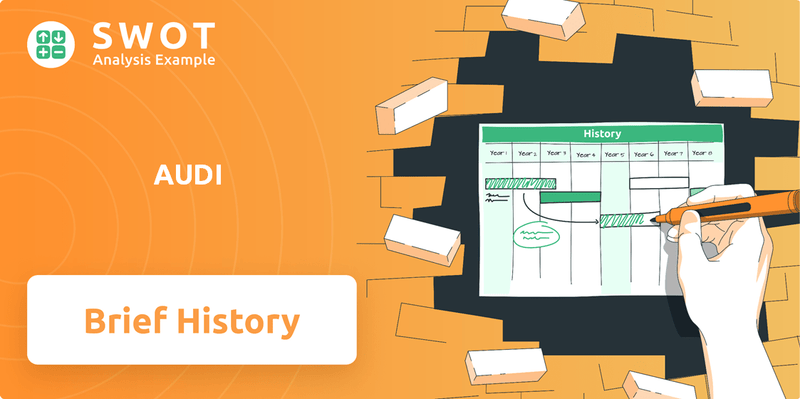
The brief history of Audi automobiles is a fascinating journey of innovation and resilience. The early Audi models, born from the vision of August Horch, laid the groundwork for the modern automotive giant we know today. Understanding Audi's founding and early years provides crucial context for appreciating its present-day achievements. This exploration into the Audi company will uncover the key milestones that shaped its legacy and its enduring impact on the luxury car market.
What is the AUDI Founding Story?
The story of the Audi company begins with August Horch, a German automotive pioneer. His journey started with a vision to create high-quality vehicles, leading to both initial success and later, the founding of a new brand. This is the brief history of the Audi brand.
Horch's ambition and innovative spirit laid the groundwork for what Audi would become. The early years were marked by challenges and the need for reinvention, ultimately shaping the company's identity and direction. Understanding these origins is key to appreciating the Audi history.
August Horch's journey in the automotive industry began with his first company, A. Horch & Cie., established in Cologne on November 14, 1899. This venture, which later became a joint-stock corporation in 1904, set the stage for his future endeavors in the German car manufacturer landscape.
- After disagreements, Horch left his initial company in 1909, driven to continue his automotive pursuits.
- Unable to use his surname, 'Horch,' for his new company due to legal restrictions, a new name was needed.
- The name 'Audi' was suggested by Franz Fikentscher's son, who proposed translating 'Horch' into Latin, resulting in 'Audi!'
On July 16, 1909, August Horch founded a new car company in Zwickau. The company was officially registered as Audi Automobilwerke GmbH Zwickau on April 25, 1910. This marked a fresh start for Horch, under a new brand name, and set the stage for the evolution of the Audi brand.
The initial focus of Audi was on producing innovative, high-quality cars. The first Audi model, the Audi Type A 10/22 hp Sport-Phaeton, was introduced in 1910. The early Audi models quickly gained a reputation for quality and performance. The Audi company also achieved success in motorsport, winning the International Austrian Alpine Rally in 1912, 1913, and 1914. The company's early success was influenced by Germany's growing industrial power and the rising demand for automobiles.
For more insights into the core values that have guided the company, check out Mission, Vision & Core Values of AUDI.
AUDI SWOT Analysis
- Complete SWOT Breakdown
- Fully Customizable
- Editable in Excel & Word
- Professional Formatting
- Investor-Ready Format
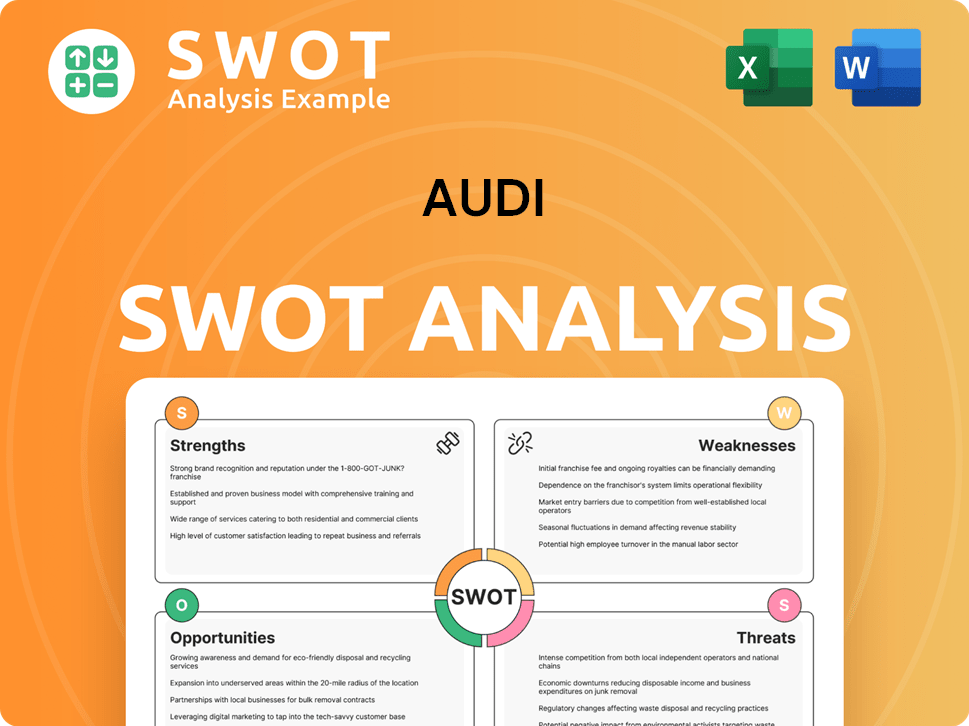
What Drove the Early Growth of AUDI?
The early growth and expansion of the Audi company were marked by significant innovations and strategic adaptations. This period saw the introduction of groundbreaking features and the formation of key alliances that shaped the Audi brand. Despite facing financial challenges and the disruptions of war, Audi history is a testament to resilience and forward-thinking in the automotive industry.
After the initial success of models like the Type A, B, and C, Audi continued to innovate. In 1923, they introduced the first Audi with a six-cylinder engine, including an oil filter and air cleaner. They also pioneered hydraulic brakes at all four wheels in Germany. In 1921, Audi became the first German car manufacturer to adopt left-hand drive and a central, floor-mounted gear lever.
In 1928, Audi was acquired by Jörgen Skafte Rasmussen, owner of DKW. A pivotal moment was the formation of Auto Union AG on June 29, 1932. This merger, initiated by Saxony's state bank, brought together Audi, DKW, Horch, and Wanderer. This created the second-largest automotive group in Germany. The four interlocking rings of the current Audi logo symbolize the unity of these four brands.
The outbreak of World War II halted civilian car production, with factories shifting to military equipment. After the war, Soviet forces dismantled Auto Union AG's production facilities. The rebirth of Auto Union GmbH in West Germany began with a parts warehouse in Ingolstadt in 1945, and the company was refounded on September 3, 1949, in Ingolstadt.
A major turning point came in 1964 when Volkswagenwerk AG acquired a majority stake in Auto Union GmbH. By the end of 1966, Audi became a fully owned VW subsidiary. The Audi brand was relaunched in 1965 with the Audi F103 series. In 1968, the Audi 100 was launched, propelling Audi into the upper mid-size segment. For more information on the Audi company and its competitors, you can check out the Competitors Landscape of AUDI.
AUDI PESTLE Analysis
- Covers All 6 PESTLE Categories
- No Research Needed – Save Hours of Work
- Built by Experts, Trusted by Consultants
- Instant Download, Ready to Use
- 100% Editable, Fully Customizable
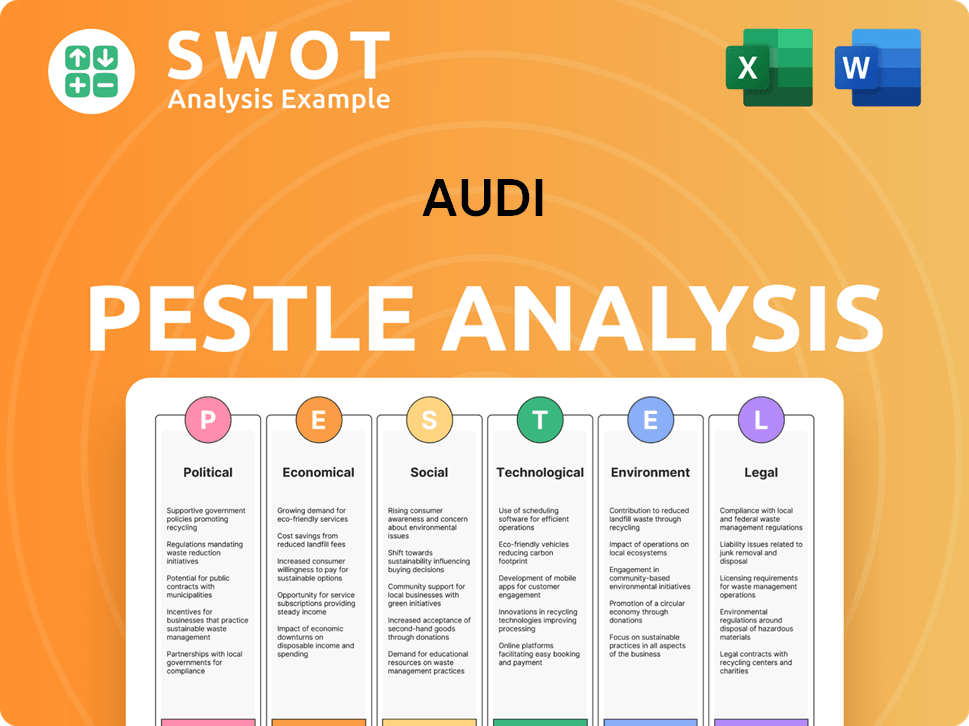
What are the key Milestones in AUDI history?
The Audi company has a rich history marked by significant milestones. From its early beginnings to its current status as a leading German car manufacturer, the brand has consistently evolved, leaving a lasting impact on the automotive industry.
| Year | Milestone |
|---|---|
| 1932 | Formation of Auto Union, a merger of four independent car manufacturers, including the original Audi. |
| 1960s | Integration into the Volkswagen Group, marking a pivotal period for the brand's resurgence. |
| 1976 | Introduction of the first five-cylinder engine in a production car. |
| 1980 | Launch of the quattro permanent all-wheel-drive system, revolutionizing the automotive industry. |
| 1985 | Officially changed its name to AUDI AG. |
| 1989 | Introduction of the Audi 100 TDI, the first diesel-engine passenger car with direct fuel injection. |
| 1990 | Release of the Audi V8, signaling a strategic move into the luxury car market. |
| 2024 | World premiere of the Audi Q6 e-tron, the first model on the new Premium Platform Electric (PPE). |
| 2024-2028 | Planned capital expenditure of EUR 41 billion, with EUR 29.5 billion allocated to BEVs and digitalization. |
The Audi brand has been at the forefront of automotive innovation throughout its history. The introduction of the quattro all-wheel-drive system in 1980 was a game-changer, providing superior performance and handling.
In 1976, Audi introduced the first five-cylinder engine in a production car, a significant engineering feat. This innovation enhanced both performance and efficiency, setting a new standard in the automotive industry.
The quattro permanent all-wheel-drive system, introduced in 1980, revolutionized the automotive sector. This technology provided superior grip and handling, initially showcased in a sports coupé, and later integrated across the Audi model range.
The Audi 100 TDI, launched in 1989, was the first diesel-engine passenger car with direct fuel injection. This innovation improved fuel efficiency and performance, contributing to the brand's reputation for technological advancement.
In 1986, Audi introduced a ten-year warranty against rust penetration for its fully galvanized bodies. This innovative approach set a new industry standard, demonstrating the brand's commitment to quality and durability.
Audi is currently undertaking its largest model initiative in company history, with more than 20 new models planned, half of which will be fully electric. This includes the Audi Q6 e-tron and A6 e-tron, showcasing its commitment to electromobility.
Audi is dedicated to sustainability, aiming to make all its production sites worldwide net carbon neutral by 2025. This commitment reflects the brand's focus on environmentally responsible manufacturing processes.
Despite its successes, the Audi company has faced several challenges throughout its history. Economic downturns, intense competition, and the transition to electromobility have tested the brand's resilience.
The company has navigated several economic downturns that have impacted its financial performance. These periods required strategic adjustments to maintain competitiveness and profitability.
Audi competes with other luxury car manufacturers, such as Mercedes-Benz and BMW, in a highly competitive market. Maintaining a strong market position requires continuous innovation and adaptation.
The shift towards electromobility presents a significant challenge, requiring substantial investment in electric vehicle technology. Audi is actively expanding its EV offerings to meet evolving consumer demands.
Difficult macroeconomic conditions, intensified competition, and political uncertainties have impacted operating profit. The Audi Group's operating profit decreased from €6.2 billion in 2023 to €3.9 billion in 2024.
Overall vehicle deliveries for the Audi brand decreased from 1,895,240 in 2023 to 1,671,218 in 2024. This decline highlights the need for strategic adjustments and market responsiveness.
The closure of its Brussels, Belgium plant in early 2025 due to a decline in orders for the large electric model it produced there. This event underscores the dynamic nature of the automotive market.
AUDI Business Model Canvas
- Complete 9-Block Business Model Canvas
- Effortlessly Communicate Your Business Strategy
- Investor-Ready BMC Format
- 100% Editable and Customizable
- Clear and Structured Layout
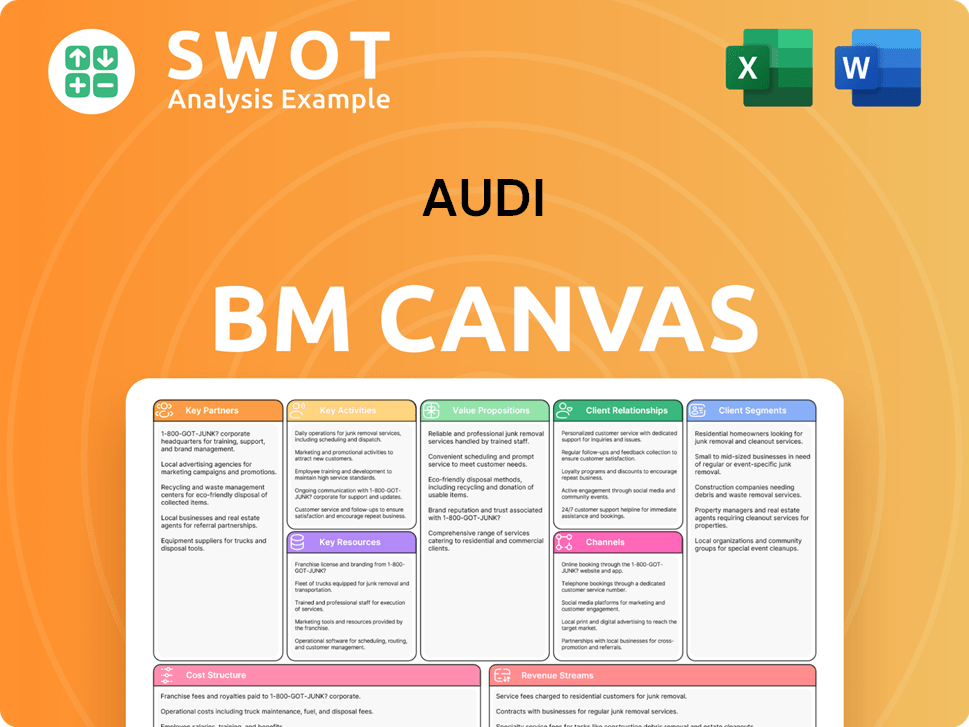
What is the Timeline of Key Events for AUDI?
The Audi history is marked by significant milestones, from its inception as A. Horch & Cie. in 1899 to its evolution into a leading German car manufacturer. Key moments include the founding of Audi Automobilwerke GmbH in 1910, the merger to form Auto Union AG in 1932, and the relaunch of the Audi brand in 1965. Audi's innovation continued with the introduction of the Audi quattro in 1980 and the Audi V8 in 1990, establishing the company's presence in the luxury car market and its impact on the automotive industry. The company has transformed over the years, reflecting its commitment to technological advancement and premium mobility.
| Year | Key Event |
|---|---|
| November 14, 1899 | August Horch establishes A. Horch & Cie. in Cologne. |
| July 16, 1909 | August Horch founds a new company, August Horch Automobilwerke GmbH, in Zwickau. |
| April 25, 1910 | The company is renamed Audi Automobilwerke GmbH Zwickau. |
| May 1910 | The first car bearing the new Audi brand name is delivered. |
| 1912-1914 | Audi achieves successive victories in the International Austrian Alpine Rally. |
| 1921 | Audi becomes the first German car manufacturer to adopt left-hand drive. |
| June 29, 1932 | Audi, DKW, Horch, and Wanderer merge to form Auto Union AG. |
| September 3, 1949 | Auto Union GmbH is refounded in Ingolstadt after World War II. |
| December 1964 | Volkswagenwerk AG acquires a majority stake in Auto Union GmbH. |
| 1965 | The Audi brand is relaunched with the Audi F103 series. |
| 1968 | The Audi 100 is launched, establishing Audi in the upper mid-size segment. |
| August 1969 | Auto Union GmbH and NSU Motorenwerke merge to form Audi NSU Auto Union AG. |
| March 1980 | The Audi quattro, with its permanent all-wheel-drive system, is introduced. |
| January 1985 | Audi NSU Auto Union AG is renamed AUDI AG, and its headquarters return to Ingolstadt. |
| 1990 | The Audi V8 is released, marking Audi's shift upscale. |
| March 2024 | The Audi Q6 e-tron, the first model on the Premium Platform Electric (PPE), is unveiled. |
Audi plans to launch over 20 new models in 2024 and 2025, with half being fully electric. This includes the Audi A6 Avant and the new Audi Q3, both expected in 2025. The company is also expanding its plug-in hybrid offerings, aiming for ten new models by the end of 2025.
Audi is committed to an all-electric model range, with a goal to be electric-only by 2033. All production sites worldwide aim to manufacture at least one electric model by the end of the decade. The company is also targeting net carbon neutrality by 2025.
Audi is strengthening its market position, particularly in the United States and China. In China, Audi is collaborating with FAW and SAIC to develop intelligent and connected electric vehicles. China-specific models will be manufactured starting in mid-2025.
Despite facing challenges in 2024 and anticipating a difficult 2025, Audi is investing significantly in its future. The company has allocated EUR 41 billion for capital expenditure between 2024-2028, with EUR 29.5 billion earmarked for battery electric vehicles and digitalization. The focus is on improving efficiency and competitiveness.
AUDI Porter's Five Forces Analysis
- Covers All 5 Competitive Forces in Detail
- Structured for Consultants, Students, and Founders
- 100% Editable in Microsoft Word & Excel
- Instant Digital Download – Use Immediately
- Compatible with Mac & PC – Fully Unlocked
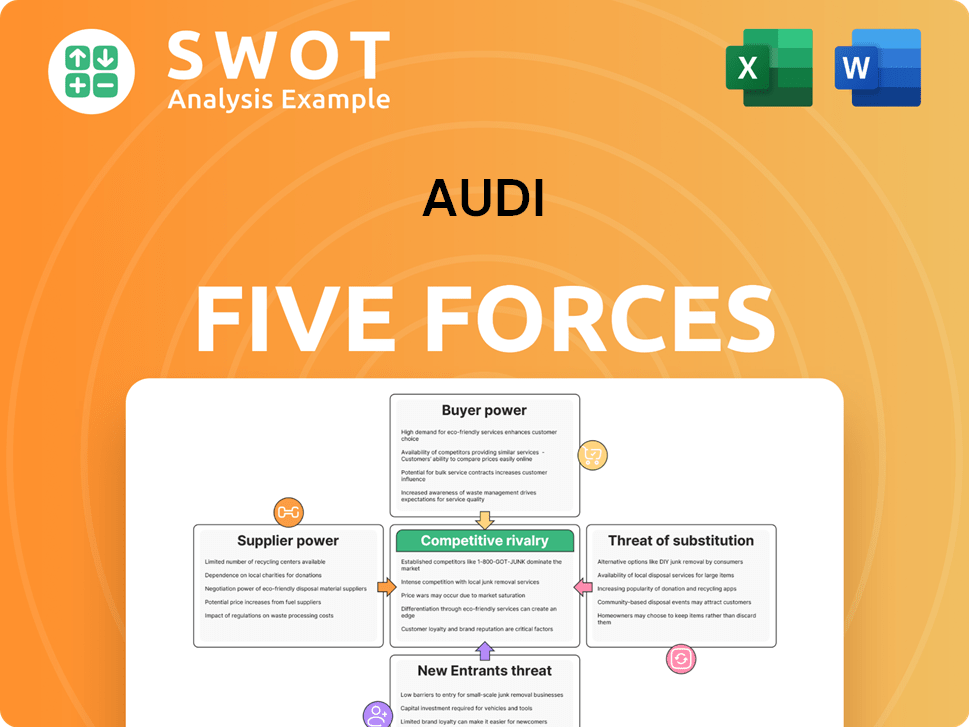
Related Blogs
- What is Competitive Landscape of AUDI Company?
- What is Growth Strategy and Future Prospects of AUDI Company?
- How Does AUDI Company Work?
- What is Sales and Marketing Strategy of AUDI Company?
- What is Brief History of AUDI Company?
- Who Owns AUDI Company?
- What is Customer Demographics and Target Market of AUDI Company?
Disclaimer
All information, articles, and product details provided on this website are for general informational and educational purposes only. We do not claim any ownership over, nor do we intend to infringe upon, any trademarks, copyrights, logos, brand names, or other intellectual property mentioned or depicted on this site. Such intellectual property remains the property of its respective owners, and any references here are made solely for identification or informational purposes, without implying any affiliation, endorsement, or partnership.
We make no representations or warranties, express or implied, regarding the accuracy, completeness, or suitability of any content or products presented. Nothing on this website should be construed as legal, tax, investment, financial, medical, or other professional advice. In addition, no part of this site—including articles or product references—constitutes a solicitation, recommendation, endorsement, advertisement, or offer to buy or sell any securities, franchises, or other financial instruments, particularly in jurisdictions where such activity would be unlawful.
All content is of a general nature and may not address the specific circumstances of any individual or entity. It is not a substitute for professional advice or services. Any actions you take based on the information provided here are strictly at your own risk. You accept full responsibility for any decisions or outcomes arising from your use of this website and agree to release us from any liability in connection with your use of, or reliance upon, the content or products found herein.